Contents
Market Overview
Macro Review
A second Non-Farm Payrolls miss doesn’t materially shift the tapering time-table. Unemployment may have ticked lower and offers the hawks something to work with. This comes as the political theatrics around the U.S. debt ceiling subsequently eased, but yields on the three-week U.S. Treasury Bill did spike to 20bp which carries a taste of August 2011 once again (S&P downgrade). Outside of the U.S. and with the end of Golden Week, expectations began to build around another RRR cut, instead the PBoC were in “net drain” mode as large OMO maturities rolled off. Sticking with China, Evergrande’s offshore creditors held their first group call with Moelis and Kirkland to discuss next steps, given private placement defaults that cross-accelerate into offshore liabilities. However, the real headline is in identifying the next casualty after Fantasia did not pay a USD maturity. Single B issuers within the Chinese Property sector saw bond prices tumble 5-40pts over the week, as the sector wrought havoc. Meanwhile, contagion is limited to China and the volatility is remarkably isolated. What is less isolated is the central bank pivot on inflation. Unlike the number of G10 central banks pivoting in September (Bank of England, Norges Bank and the Reserve Bank of New Zealand), the National Bank of Poland followed other CEE economies in hiking rates. However, the manner of the 40bp hike is noteworthy, given the pressure from three former central bank governors and a letter of “guidance” from the Prime Minister. The ultra-dovish narrative is a thing of the past across CEE economies and the inflationary shift was as extreme as the Bank of England’s action three weeks ago, which also moved the U.S. Treasury market. We think it’s right that investors focus on German 10yr breakevens at 8yr highs, US 10yr breakevens north of 2.50% and oil up at 7yr highs, but Polish interest rate expectations (as in the 1y1yr swap curve) are 45bp wider this week and 100bp wider over two weeks.
EM Credit Update
EM Credit ended the week down 0.3% with High Yield indices down 0.6% as U.S. Treasuries widened 9-14bp. Ecuador, El Salvador and Argentina outperformed, while Ethiopia, Sri Lanka and Tunisia lagged. Most of the focus of the week focused on the ETF tracking the EM Sovereign Index (EMB) as it traded at a discount to NAV implying asset class outflows.
The Week Ahead
IMF and World Bank meetings will begin in earnest next week. On top of that the IMF/WB will update global growth forecasts, which ought to take into account lower U.S. and China GDP growth and highlight further EM and DM dispersion. Equally, we may learn of Fed Chair Powell’s reappointment as soon as Tuesday with PredictIt odds now as high as 70% already. Then, after the second NFP miss, inflation will be due on Wednesday, although such events are unlikely to materially alter the Fed’s tapering path. Meanwhile, Singapore will be out with 3Q GDP but the monetary authority (MAS) is expected to tighten policy (0.6%). Singapore could feature as the second Asian central bank to hike rates after South Korea last month. Other rate decisions include South Korea (0.75%) and Chile (1.5%). Just as the economic calendar lightens, US earnings will dominate the headlines. The 3Q earnings season kicks off with JP Morgan, Bank of America, Citi and Goldman Sachs, among others.
Highlights from emerging markets discussed below include: A cabinet reshuffle in Peru; constructive steps in Ethiopia, but headwinds remain; and thoughts on ability versus willingness to pay.
Fixed Income
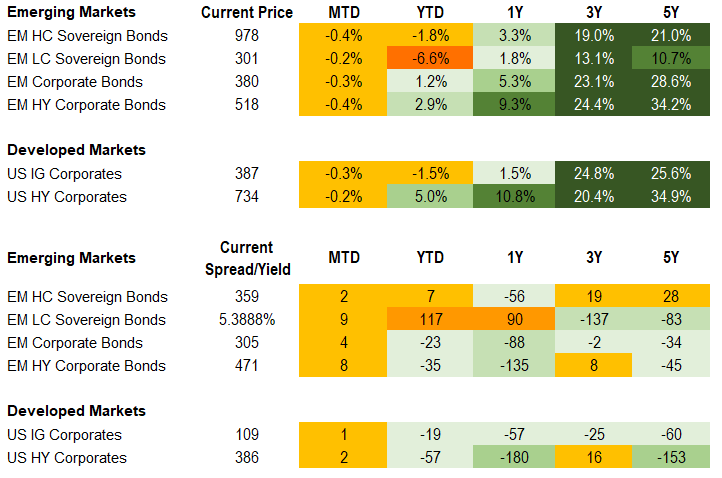
Equities
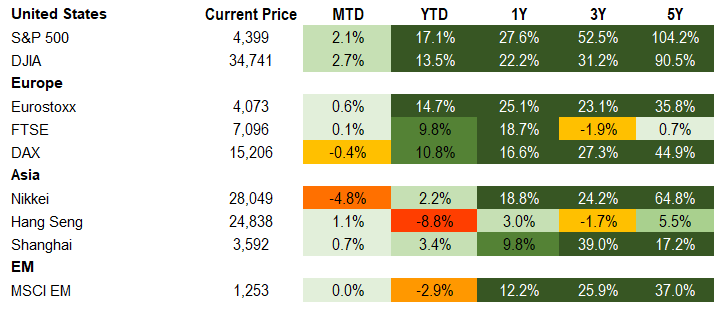
Commodities

Source for data tables: Bloomberg, JPMorgan, Gramercy. EM Fixed Income is represented by the following JPMorgan Indicies: EMBI Global, GBI-EM Global Diversified, CEMBI Broad Diversified and CEMBI Broad High Yield. DM Fixed Income is represented by the JPMorgan JULI Total Return Index and Domestic High Yield Index. Fixed Income, Equity and Commodity data is as of October 8, 2021 (mid-afternoon).
Emerging Markets Weekly Highlights
Peru cabinet reshuffle should improve near-term governability dynamics
Event: President Pedro Castillo announced new cabinet appointments this week including the Heads of Cabinet, Labor, Culture, Interior, Mining and Energy, Education, and Production. The changes encompass a mixed set of appointments with comparatively more moderate officials as well as individuals from the ruling Peru Libre party. Most notably, leftist Mirtha Vazquez will take over the Head of Cabinet post from ideological Cerron loyalist Guido Bellido and the new Mining and Energy Minister, Eduardo Gonzalez, hails from the private sector.
Gramercy Commentary: The development appears to be an effort to improve government functionality and reduce tensions between the more ideological and moderate factions of the Administration and Congress. Vazquez previously served as President of Congress under interim President Sagasti, so while still leftist, she is more experienced with a more centrist and digestible approach than Bellido. The new cabinet must be approved via confidence vote in the next month with a simple majority. Cerron has indicated that the party does not support the adjustments and Castillo will need to rely on other parties for support, implying moderation in the near-term. The discontent of the ruling party regarding Castillo’s decision to reshuffle combined with Castillo’s ultimate policy platform still keep uncertainty and governance risks elevated, albeit to a lesser extent than pre-reshuffle, assuming it’s successful.
The formation of a new cabinet with opposition participation is a constructive step for Ethiopia, but the country continues to face a number of significant political and economic headwinds
Event: This week, embattled Ethiopian Prime Minister, Abiy Ahmed, was sworn in for a second five-year term and named a cabinet that includes prominent opposition leader Berhanu Nega as Minster of Education. In the meantime, the U.S. and UN seem set to ramp up pressure on Abiy’s Administration in the context of raging military conflict and humanitarian crisis in the country’s Tigray region, while revelations about “hidden” Chinese debts might further complicate the ongoing efforts to restructure sovereign obligations under the G20 Common Framework.
Gramercy Commentary: The inclusion of opposition figures in the new administration sends a good signal about efforts to begin something that resembles a reunification process of society in the face of acute political, social and ethnic divisions. However, there are no signs that a resolution of the Tigray military conflict could be on the table any time soon. As such, both the UN and the Biden Administration appear likely to intensify their pressure on the Ethiopian authorities, including via potential further economic sanctions from the U.S. and other western powers. This week, in front of the UN Security Council, Secretary-General Antonio Guterres called the Ethiopian Government’s decision to expel seven senior UN officials from the country “particularly disturbing” and described the situation in Tigray as a potential “massive human tragedy”. Meanwhile, the Ethiopian government and its major creditors, including China and France, finally managed to set up a committee to restructure around $30bn of external debt as part of the G20 Common Framework initiative, but progress on that front is likely to remain elusive within the existing structure and would require new ideas/solutions, in our view. Recent reports about “hidden” debts owed to China not covered under official public debt statistics are likely to complicate matters further. Against this backdrop, Ethiopia’s sovereign debt has sold-off materially this year. In this environment, EM investors are facing a difficult task to evaluate the risk/reward balance against political/geopolitical risks that are unlikely to get resolved in the near-term as well as ESG concerns.
Global emerging markets corporates in focus: Can’t pay or won’t pay?
Event: On October 4, Fantasia Holdings announced that a USD-denominated bond due to mature on that day was not repaid. The remaining principal amount outstanding is just under $206mm. The price of the bond fell by over 70 points. At the time of writing, it was quoted in the mid-20s. The price action suggests the market expected these notes to be repaid. This has raised questions about the predictability of non-payment events.
Gramercy Commentary: An issuer’s ability to pay is clearly important. Liquidity-related disclosures contained in the latest financial statements are typically used to assess this. In some cases, there may be significant gaps between the publication dates of such disclosures. This can mean that the market’s assessment of the ability to pay is based on somewhat stale information. Payment ability is far from being the only factor, however. Where sufficient liquidity appears to be available, whether or not payments are made may also depend on an issuer’s willingness to pay. Several factors can impact this including market conditions and the ease (or otherwise) of refinancing, the maturity schedule (considering private and public liabilities), the terms of the relevant securities and the issuer’s perception of the repercussions of non-payment. The issuer’s payment track record is also important, though past decisions may not be adequate indicators of future behavior. If a payment is missed, remedies available to bondholders become the focus. Considerations which can impact this include the issuer’s jurisdiction and status within it (even where notes are not issued under local law). The terms of the notes will be as important to bondholders as to issuers, with holders potentially focusing on what constitutes an event of default and who determines this, any cross-default considerations, details of the trustee, the nature of any security amongst other factors. The nature of the bondholder base is another factor – fragmented ownership may prove more difficult to organize into the requisite groupings than concentrated holdings and retail bonds may be viewed differently by issuers and/or relevant authorities versus notes mainly held by institutional investors. Added to all this, the potential costs to bondholders – which include legal and other representation, court fees, travel and related expenses – need to be considered, regularly, vis-à-vis the sometimes unpredictable gains from a favorable outcome. Fantasia Holding’s decision not to repay a USD206mn bond at the final maturity has added to concerns about Chinese property developers; many of which were already under pressure due to the well-flagged events at China Evergrande Group. This is an unintended, but unsurprising consequence. Bond price changes in the sector this week highlight the need for analysis which not only focuses on individual issuers’ metrics but also takes sector dynamics and peers’ fundamentals into consideration. Such in-depth analysis is a key characteristic of active portfolio management.
Emerging Markets Technicals
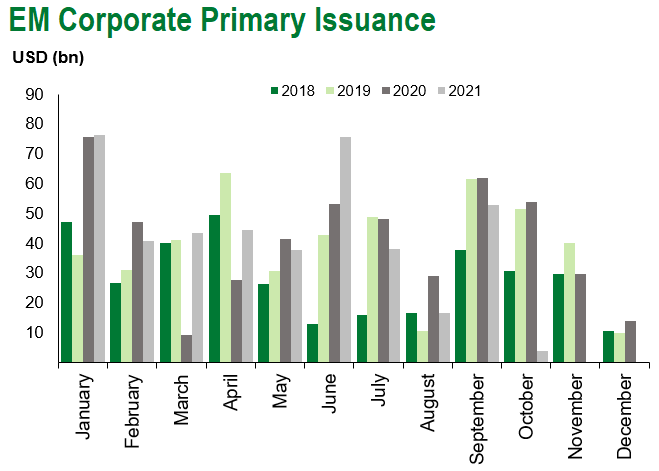
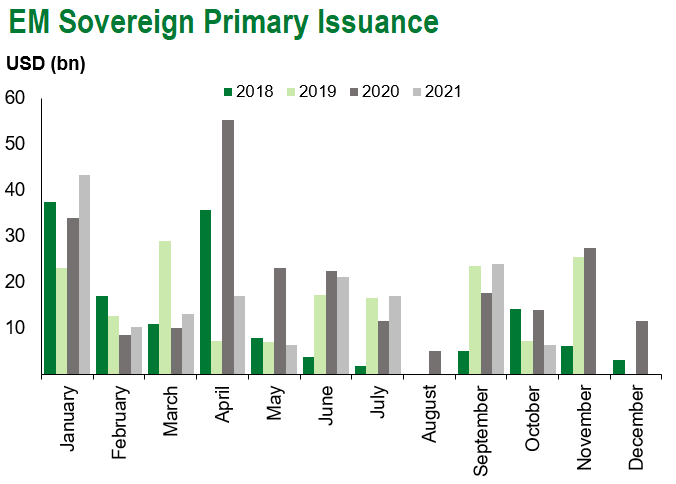
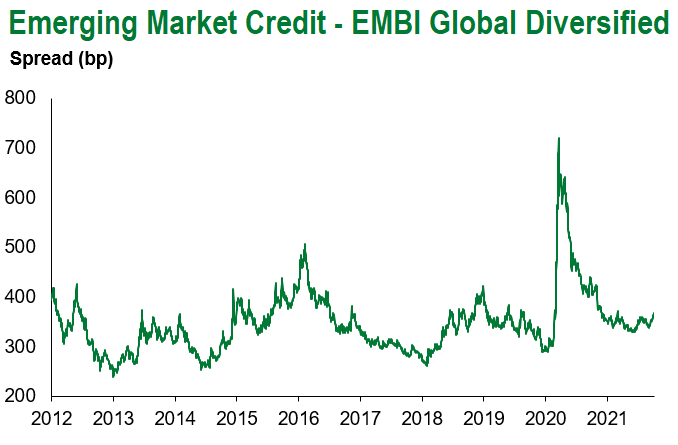
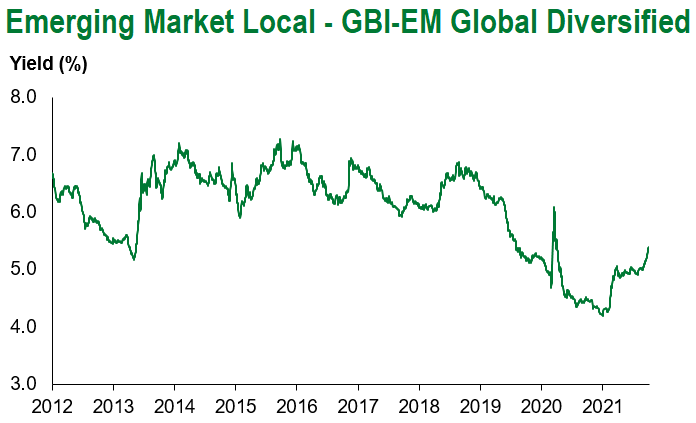
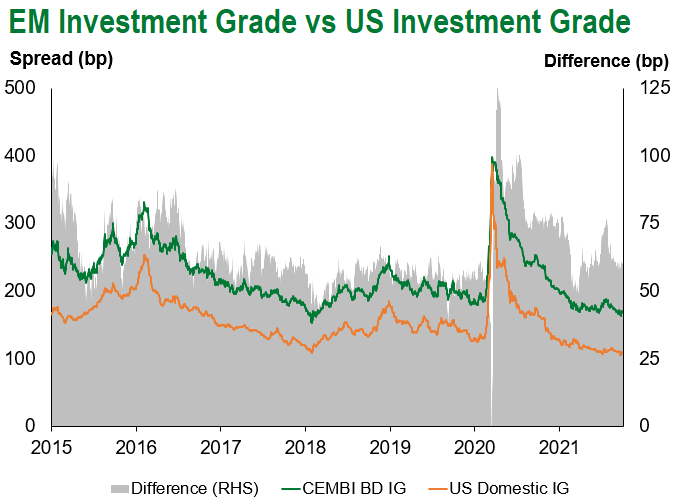
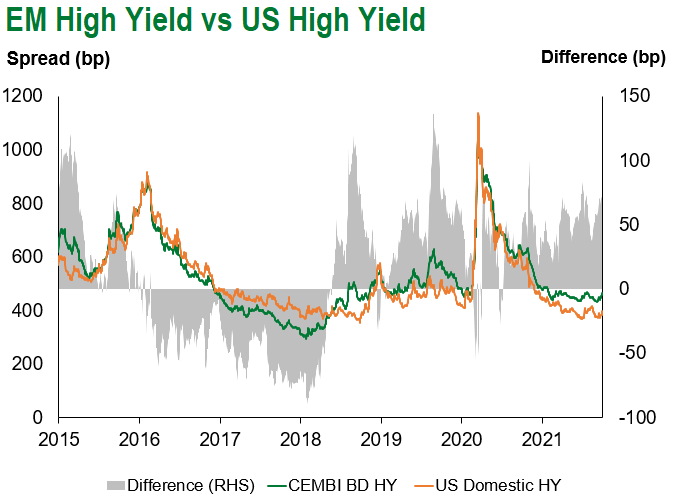
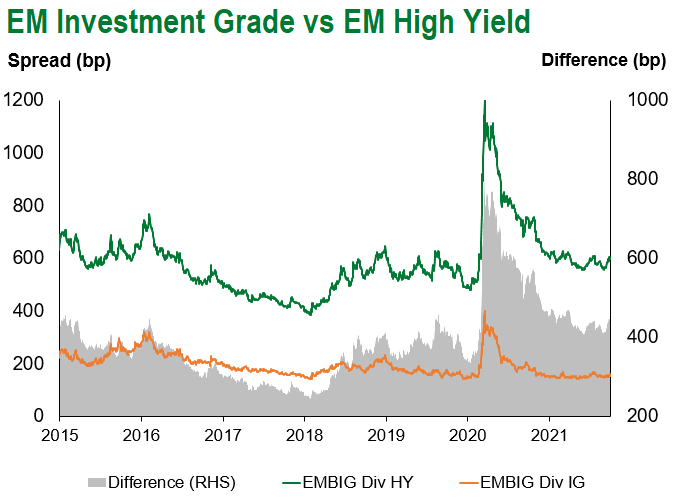
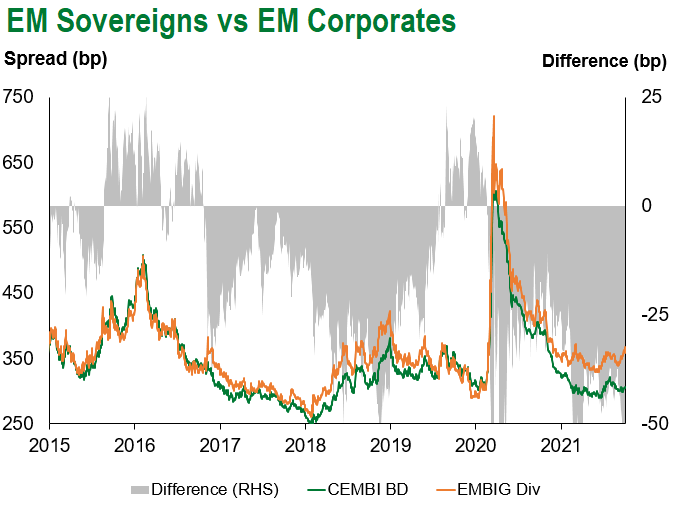
Emerging Markets Flows
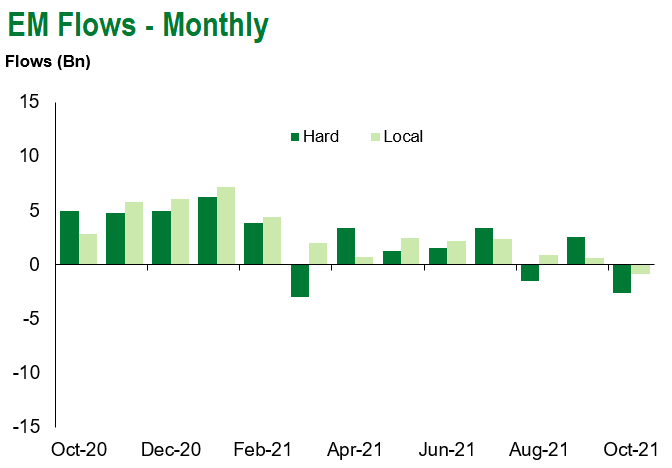
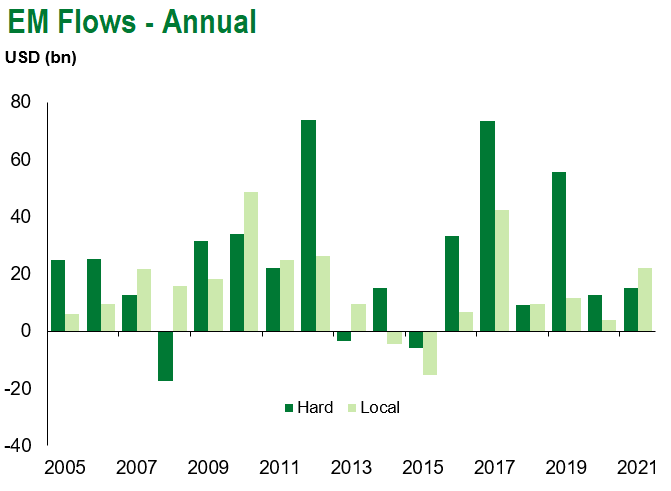
Source for graphs: Bloomberg, JPMorgan, Gramercy. As of October 8, 2021.
COVID Resources
Emerging Markets COVID-19 Case Summary
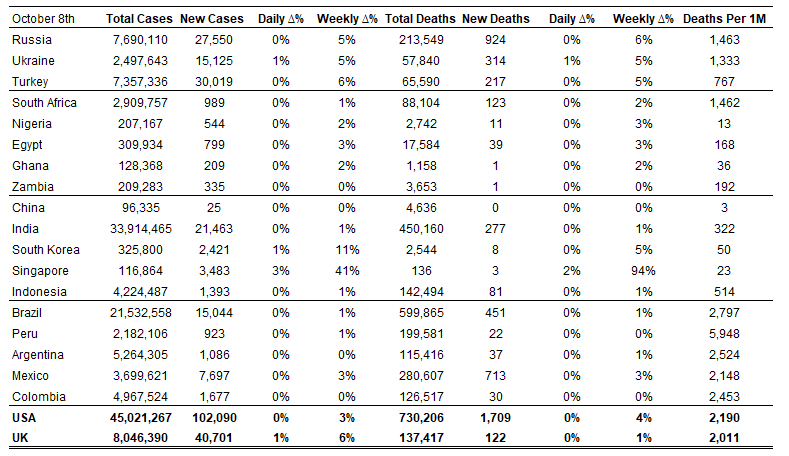
Source: Worldometer as of October 8, 2021.
Additional Crisis Resources:
Johns Hopkins COVID-19 Case Tracker
For questions, please contact:
Kathryn Exum, Senior Vice President, Sovereign Research Analyst, [email protected]
Petar Atanasov, Senior Vice President, Sovereign Research Analyst, [email protected]
Tolu Alamutu, CFA, Senior Vice President, Corporate Research Analyst, [email protected]
James Barry, Vice President, Corporate Research Analyst, [email protected]
This document is for informational purposes only. The information presented is not intended to be relied upon as a forecast, research or investment advice, and is not a recommendation, offer or solicitation to buy or sell any securities or to adopt any investment strategy. Gramercy may have current investment positions in the securities or sovereigns mentioned above. The information and opinions contained in this paper are as of the date of initial publication, derived from proprietary and nonproprietary sources deemed by Gramercy to be reliable, are not necessarily all-inclusive and are not guaranteed as to accuracy. This paper may contain “forward-looking” information that is not purely historical in nature. Such information may include, among other things, projections and forecasts. There is no guarantee that any forecasts made will come to pass. Reliance upon information in this paper is at the sole discretion of the reader. You should not rely on this presentation as the basis upon which to make an investment decision. Investment involves risk. There can be no assurance that investment objectives will be achieved. Investors must be prepared to bear the risk of a total loss of their investment. These risks are often heightened for investments in emerging/developing markets or smaller capital markets. International investing involves risks, including risks related to foreign currency, limited liquidity, less government regulation, and the possibility of substantial volatility due to adverse political, economic or other developments. The information provided herein is neither tax nor legal advice. Investors should speak to their tax professional for specific information regarding their tax situation.